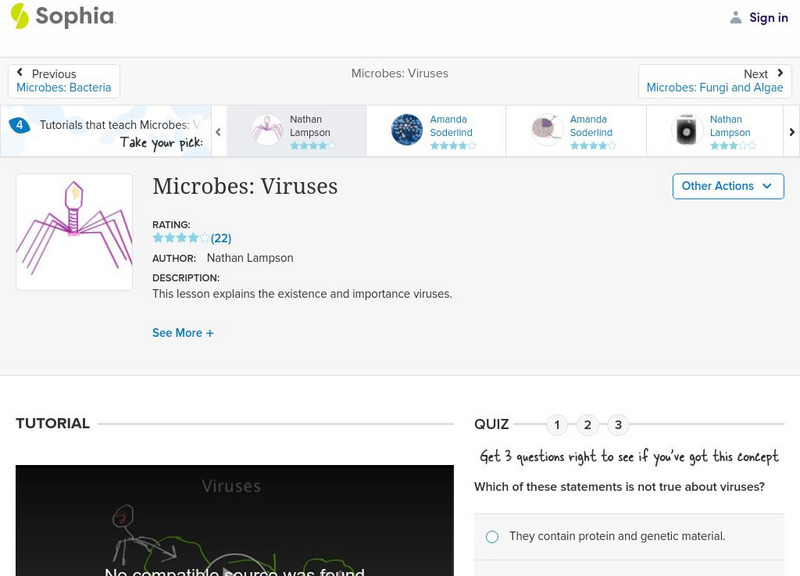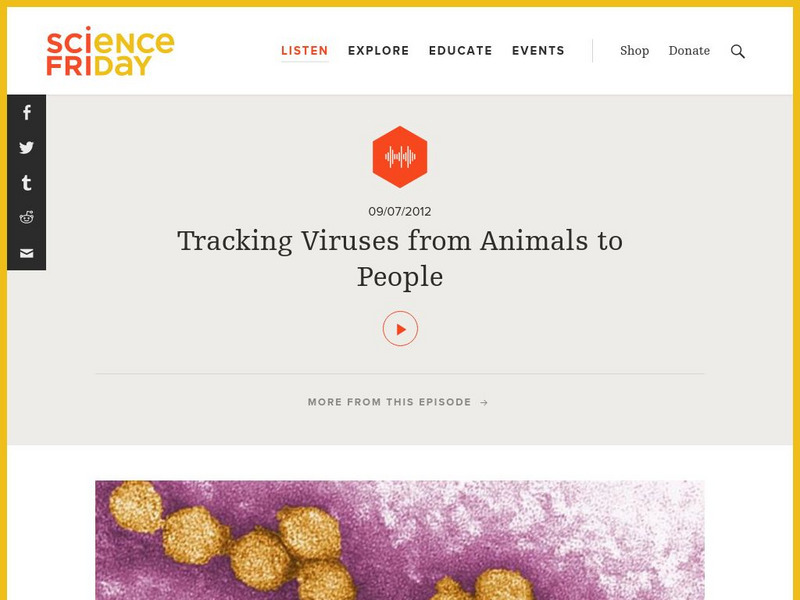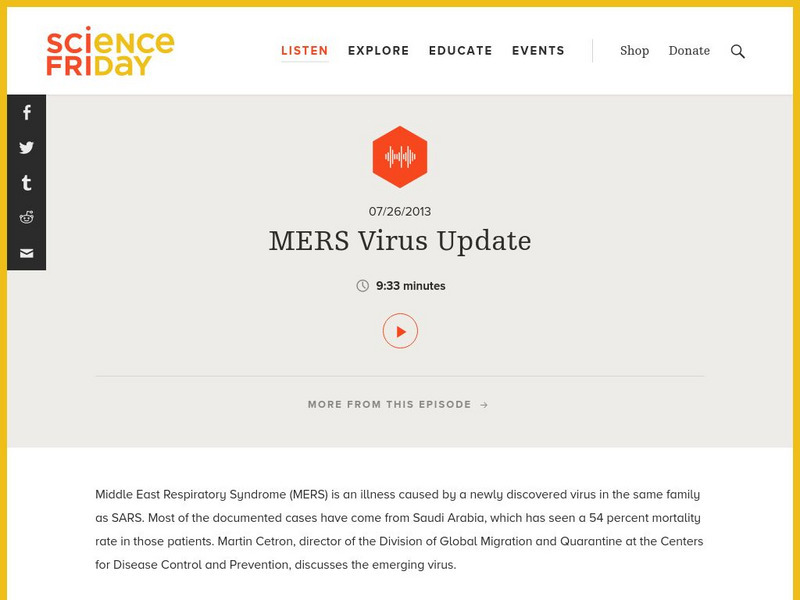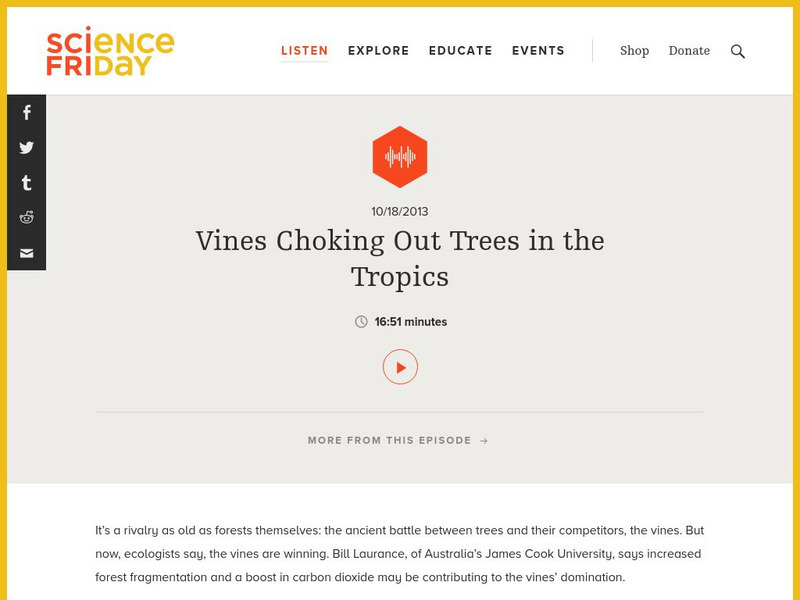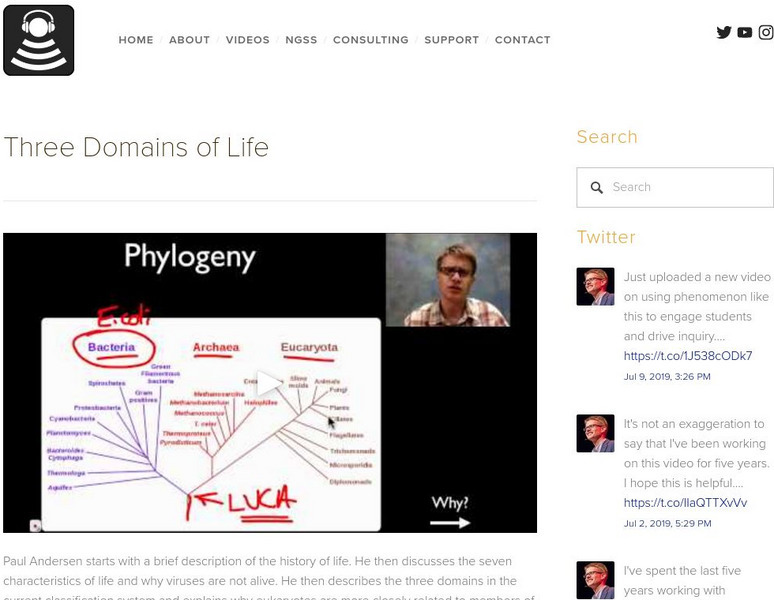Hi, what do you want to do?
Khan Academy
Khan Academy: Virus Structure and Classification
A video exploring how viruses are good about being hackers! Look at the properties of viruses that make them unique. [11:04]
PBS
Pbs Learning Media: Spillover Zika, Ebola & Beyond: Part 8: Dodging Bullets
The highly contagious and pandemic nature of Ebola was exposed in 2014, when an infected US diplomat flew from Liberia to Nigeria, exposing dozens of passerby and doctors along the way. Contact tracing and quarantine can contain an...
PBS
Pbs Learning Media: Spillover Zika, Ebola & Beyond: Part 7: A New Foe Emerges Nipah
In 1988 Southeast Asia faced it's own battle with Nipah, a fruit bat-borne disease that kills more than three quarters of those infected. Nipah is only contracted in Bangladesh between the months of December and March, and this was a...
PBS
Pbs Learning Media: Spillover Zika, Ebola & Beyond: Part 5: Contact Tracing
Find out why contact tracing is such a crucial part of controlling outbreaks of infectious disease. Tracing back to patient zero during the West African Ebola outbreak shed light on Ebola's zoonotic origins and rapid spread. Contact...
PBS
Pbs Learning Media: Spillover Zika, Ebola & Beyond: Part 9: The Predict Project
See Jonna Mazet's innovative PREDICT Project in action. PREDICT is a worldwide effort to use animal surveillance to monitor viruses, proactively preventing and containing outbreaks of infectious disease by identitifying points of...
PBS
Pbs Learning Media: Spillover Zika, Ebola & Beyond: Part 6: Zika Transmission
Zika, unlike Ebola, is less commonly spread by human-to-human contact. Instead, mosquitos are the root cause. Brazil has recently implemented mosquito controls to prevent the transmission of several viral diseases, including Zika. As the...
Science Friday Initiative
Science Friday: A Virus That Affects Caterpillar Behavior
An audio lecture on how a virus known as baculovirus infecting caterpillars changes their behavior which is advantageous to the spread of the virus. Learn that when the gypsy moth caterpillars become infected they climb for treetops. At...
Science Friday Initiative
Science Friday: Carl Zimmer Explores the Weird Lives of Viruses
In A Planet of Viruses, Zimmer writes of viruses that cause cancer and others that cure disease.
Science Friday Initiative
Science Friday: The Virus in Your Genes
Many vertebrate species contain snippets of viral genetic code within their genomes -- and according to new research, it's not all from the likely suspects.
Science Friday Initiative
Science Friday: Phages Fight Bacteria
In this segment, Ira and guests talk about bacteriophages -- bacteria-fighting viruses -- and their place in modern medicine.
Science Friday Initiative
Science Friday: Viral Bacteria Killers
Could engineered viruses help conquer antibiotic-resistant bacteria?
Science Friday Initiative
Science Friday: The Real Virologist Behind Contagion
W. Ian Lipkin discusses his off-screen roles in the movie Contagion.
Sophia Learning
Sophia: Microbes: Viruses: Lesson 2
This lesson explains the existence and importance viruses. It is 2 of 4 in the series titled "Microbes: Viruses."
California Academy of Sciences
California Academy of Sciences: Understanding Viruses
Studying the evolutionary history of viruses Shannon Bennet is facinated by the life history of parasitism. Where do these Viruses occur in nature, how many of them are there, and how do they switch into new hosts?
Science Friday Initiative
Science Friday: Tracking Viruses From Animals to People
Researchers discuss West Nile, hantavirus, and other diseases that cross from animals to people.
Science Friday Initiative
Science Friday: Busting Bad Bacteria With Their Viral Enemies
Phages added to packaged beef or spinach could cut down on E. coli bacteria outbreaks.
Science Friday Initiative
Science Friday: Mers Virus Update
An update on a SARS-like virus centered in the Middle East.
Science Friday Initiative
Science Friday: Vines Choking Out Trees in the Tropics
Increased forest fragmentation and a boost in carbon dioxide may contribute to the vines' success.
Bozeman Science
Bozeman Science: Viral Replication
Paul Andersen explains how viruses reproduce using the lytic cycle. He also shows how viruses can pick up new genetic material and how retroviruses (like HIV) can enter into the lytic cycle. He also describes the lysogenic cycle and how...
Bozeman Science
Bozeman Science: Three Domains of Life
Paul Andersen starts with a brief description of the history of life. He then discusses the seven characteristics of life and why viruses are not alive. He then describes the three domains in the current classification system and...
Bozeman Science
Bozeman Science: Viruses
Paul Andersen describes the important characteristics of viruses. He starts with a brief description of origin theories. He then describes the two characteristics of all viruses; genetic information and protein coats. He also describes...
Howard Hughes Medical Institute
Hhmi: Bio Interactive: Retroviruses and Viral Diversity
A concise summary of the main differences between retroviruses and those which use DNA in their genome. A few examples of each type of virus are shown.













